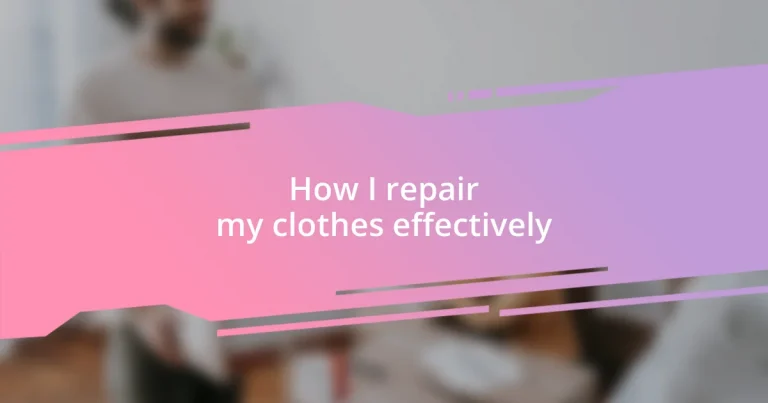Key takeaways:
- Understanding basic sewing techniques like running stitch and backstitch is crucial for effective clothing repair, enhancing durability and confidence in mending.
- Identifying types of fabric damage early, such as snags or tears, is essential to prevent minor issues from becoming larger problems.
- Employing creative repair techniques like darning, appliqué, and embroidery transforms mended items into unique, personalized pieces, while proper maintenance extends their longevity.

Understanding basic sewing techniques
When I first started sewing, it felt like learning a new language. Basic techniques, such as the running stitch, backstitch, and whip stitch, may seem simple at first, but each serves a unique purpose in mending clothes. Have you ever tried to fix a hem but found the results uneven? That’s where mastering these stitches can really boost your confidence.
I remember the first time I used a backstitch; it was both frustrating and rewarding. It creates a strong seam that’s perfect for areas that need extra durability, like underarms or seat seams. My frustration melted away as I watched the thread lock in place, knowing I’d repaired something that would last.
Using the right tools is just as crucial as knowing the stitches. A good pair of fabric scissors can make all the difference—trust me; I’ve had my share of dull scissors that ruined a project! Don’t underestimate the power of a well-organized sewing kit. Have you ever searched for that elusive needle? A tidy space can turn a simple repair into an enjoyable experience.

Identifying types of fabric damage
Identifying fabric damage is the first step in knowing how to repair it effectively. I’ve encountered various types of damage over the years, some of which seem minor at first glance but can lead to bigger problems if untreated. A small snag, for example, might look innocuous, but if it’s not addressed quickly, it could unravel further, turning a quick fix into a much larger sewing project.
Here are some common types of fabric damage I’ve come across:
- Snags: These are pulls in the fabric caused by rough surfaces or catching on jewelry.
- Tears: Often occur due to excessive stress on seams or accidental rips.
- Pills: Small balls of fiber that form on the surface, often from friction.
- Faded areas: Result from prolonged exposure to sunlight or harsh washing.
- Stains: These might range from food spills to ink marks, which need immediate attention.
Each type of damage tells a story about how the fabric has been used, and addressing them promptly makes all the difference in prolonging the life of your garments. I once found a beautiful shirt with a few unsightly pills – it was disheartening at first, but I realized that a simple fabric shaver turned it into a fresh piece again!

Step by step patching methods
Patching is an invaluable technique for repairing damaged clothing, and the approach can vary depending on the extent and type of damage. For instance, when I encounter a small tear, I generally employ a simple patch method using fabric scraps or an iron-on patch. The first thing I do is trim any frayed edges around the tear, making sure to clean up the area to ensure a smooth application. Then, I cut a patch that extends at least half an inch beyond the tear on all sides. I place the patch underneath the damaged area, either securing it with fabric glue or stitching it in place—it’s both satisfying and practical!
In contrast, dealing with larger holes requires a bit more finesse and creativity. Once, I faced a particularly stubborn hole in my favorite jeans. I opted for a visible mending technique, using contrasting thread that added a unique flair to the garment. After cleaning the hole’s edges, I cut a patch slightly larger than the hole. I then bested the area with a delightful embroidery pattern around the edges, blending art with repair. This method not only fixed my jeans but also transformed them into a statement piece, reminding me that clothing can tell a story rather than hide imperfections.
Once you’ve chosen your patching method, it’s crucial to secure it properly to extend the lifespan of your repair. I often use a sewing machine for durability, but I’ve also hand-stitched patches in a pinch. When using fabric glue, I make sure to let it dry completely before wearing the item again. This attention to detail can mean the difference between a quick fix and a long-lasting solution.
| Patching Method | Description |
|---|---|
| Simple Patch | Ideal for small tears; uses fabric scraps and requires cutting the patch larger than the damage. |
| Visible Mending | Great for larger holes; combines aesthetics with functionality using contrasting thread and decorative stitching. |
| Fabric Glue Application | Quick fix alternative; ensures a neat repair without sewing, but requires drying time. |

Repairing seams and stitches
Repairing seams and stitches can feel like a daunting task, but it’s more approachable than it seems. In my experience, I’ve often found small seam splits at the shoulders of my favorite tops, which can lead to bigger problems if left unchecked. Fixing these requires a straightforward approach—first, I always reinforce the seam by using a backstitch technique. It feels reassuring to know that I’m not just covering a problem, but enhancing the integrity of the fabric.
When I think about stitches, I recall a moment when I accidentally caught my sweater on a door handle, leaving a conspicuous hole. Initially, I felt a wave of frustration; I love that sweater! But then, I decided to embrace the repair process. I carefully picked out the loose threads and stitched them back down, making sure to use a matching thread to keep it subtle. Wasn’t it amazing how a simple needle and thread could revive my favorite piece? The act of repairing not only saved the sweater, but it also infused it with a story of resilience.
Seams are not just functional; they’re the silent heroes of our garments. One tip I swear by is to always press the seams open after repairing—this makes the finished repair look much neater and professionally done. I sometimes wonder, how many pieces of clothing have I saved this way? It’s a little victory that adds to my confidence as a DIYer. Each stitch I make is a step toward craftsmanship and self-reliance, and honestly, I enjoy every moment of it.

Creative techniques for clothing repair
When I think about creative techniques for clothing repair, one of my favorites has to be fabric darning. It’s a method that feels almost like art to me. Picture this: I once had a beloved sweater that developed a hole in the elbow. Instead of a simple patch, I grabbed some colorful worsted yarn and began weaving it back together, crisscrossing the threads like a mini tapestry. The result was not only a fix but a beautiful, vibrant accent that gave the sweater a new lease on life. Sometimes, I wonder if embracing imperfections can make our clothes even more special.
Another technique that I cherish is using appliqué, which adds personality to repairs. I recall a time when I had a pair of shorts that wore out near the pockets. Instead of just replacing them, I decided to turn the damage into a design feature. I found intricate fabric scraps that matched my style and cut them into fun shapes, carefully stitching them over the worn areas. The shorts took on a playful vibe, and I felt pride in knowing that my creative touch turned a mistake into something uniquely mine. Have you ever considered how a bit of creativity can completely transform your view of an item?
Lastly, I find that embroidery can work wonders not just for repair but for embellishment. I had a simple black dress, which I loved but felt was a bit too plain. After sewing a small tear near the hem, I took the opportunity to stitch delicate floral designs along the repaired edge. As I sat there stitching, I felt a sense of calm wash over me. It was therapeutic in some way, almost like meditation. The result? A chic dress that sparked compliments and conversations about the personal touches I integrated into a simple repair. Isn’t it fascinating how the act of repairing can become a canvas for expressing your creativity?

Maintaining clothes after repair
Maintaining clothes after a repair is an essential aspect that often gets overlooked. After I mend something, I make it a point to wash it gently, especially if I used a hand-stitched method. I learned the hard way that more delicate repairs can unravel if subjected to rough cycles. It’s a small step, but it adds longevity, and I always think, isn’t it worth taking the extra care when I’ve already invested time in fixing it?
One thing I’ve adopted is to use a fabric protector spray after repairs. I remember a time when I eagerly wore my freshly mended jeans, only to spill some coffee on them later—what a disaster! Now, I take a few moments to spray a fabric protector before I wear anything new or freshly fixed. It doesn’t guarantee against all stains, but it definitely gives me a fighting chance. When was the last time you went for a protective measure like this?
Lastly, I find it invaluable to store repaired items with care. When I put something back in my closet, I like to fold it neatly and keep it away from any harsh light that might cause fading. Transitioning from repair to maintenance might seem trivial, but that little effort means I can keep enjoying my beloved pieces for much longer. Sometimes, I reflect on my sustainable fashion journey, and I’m proud of how these mindful habits reflect my commitment to preserving not just my clothes, but the environment too. What habits have you picked up to extend the life of your repaired clothes?














